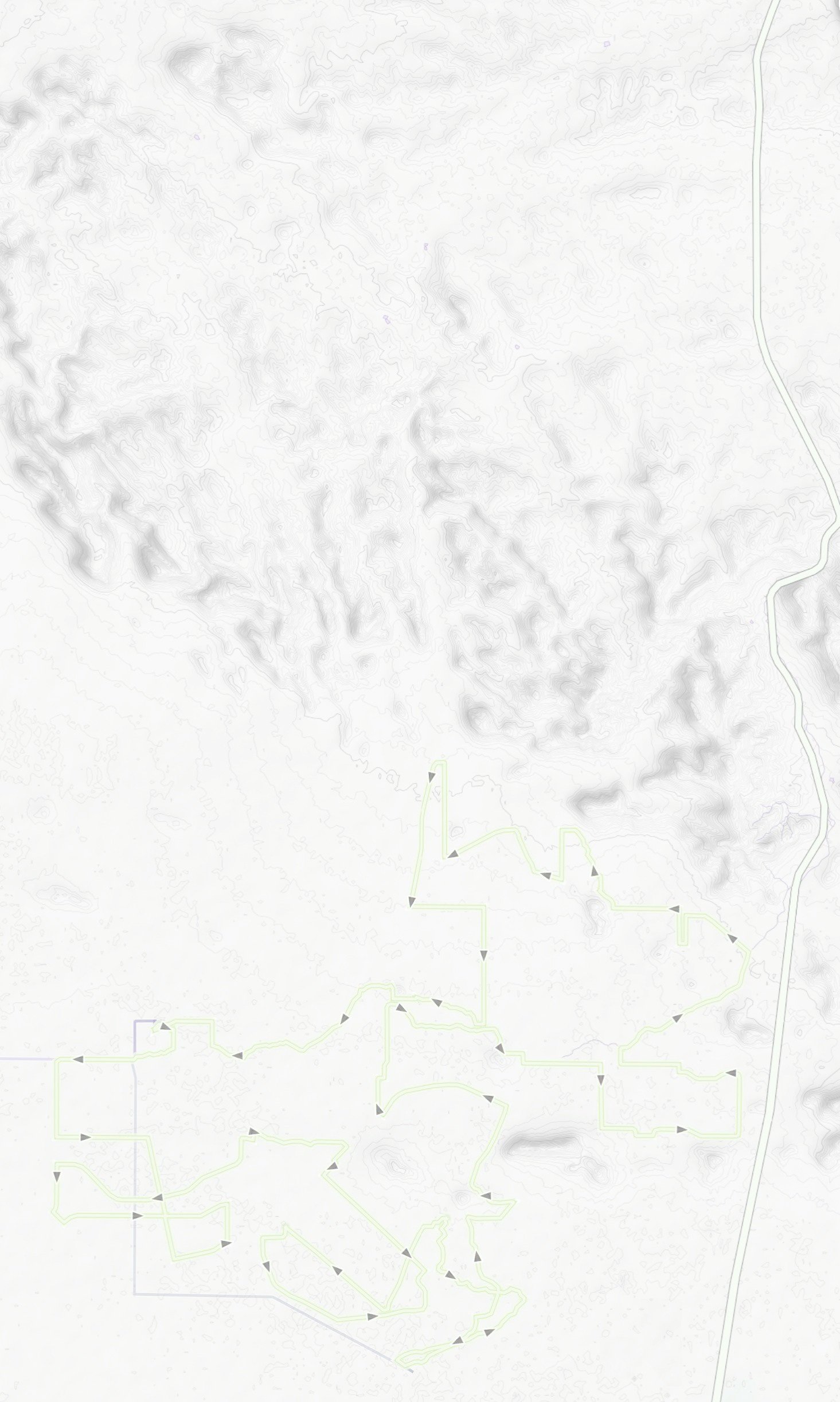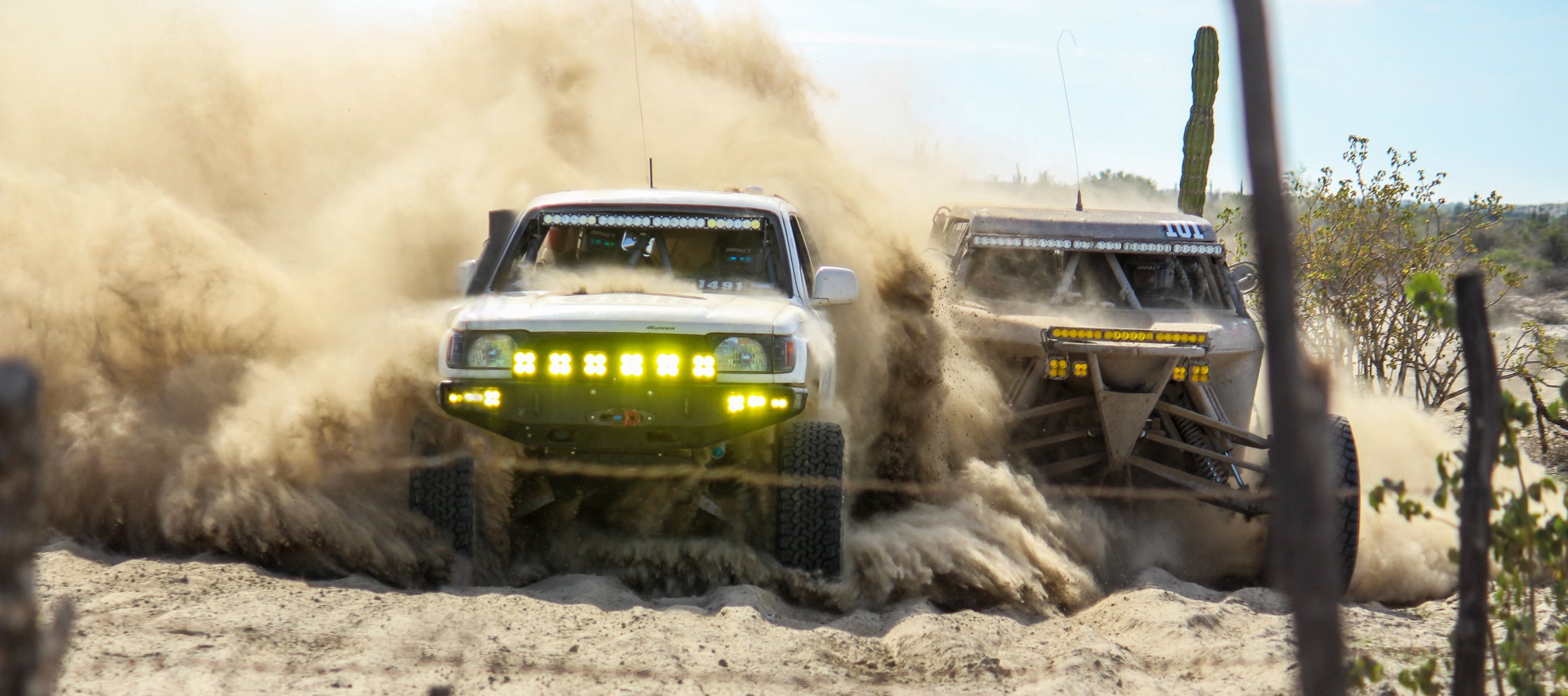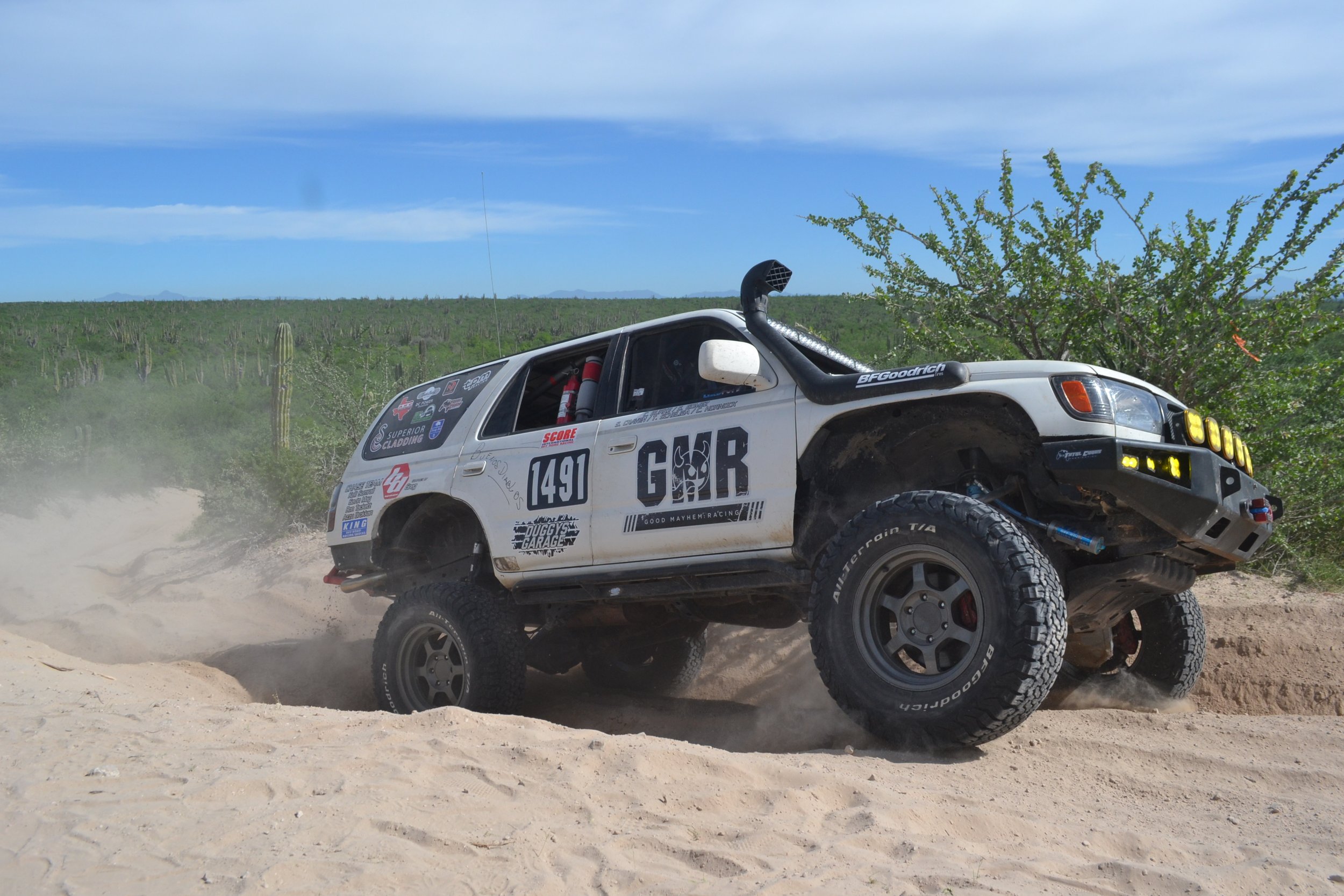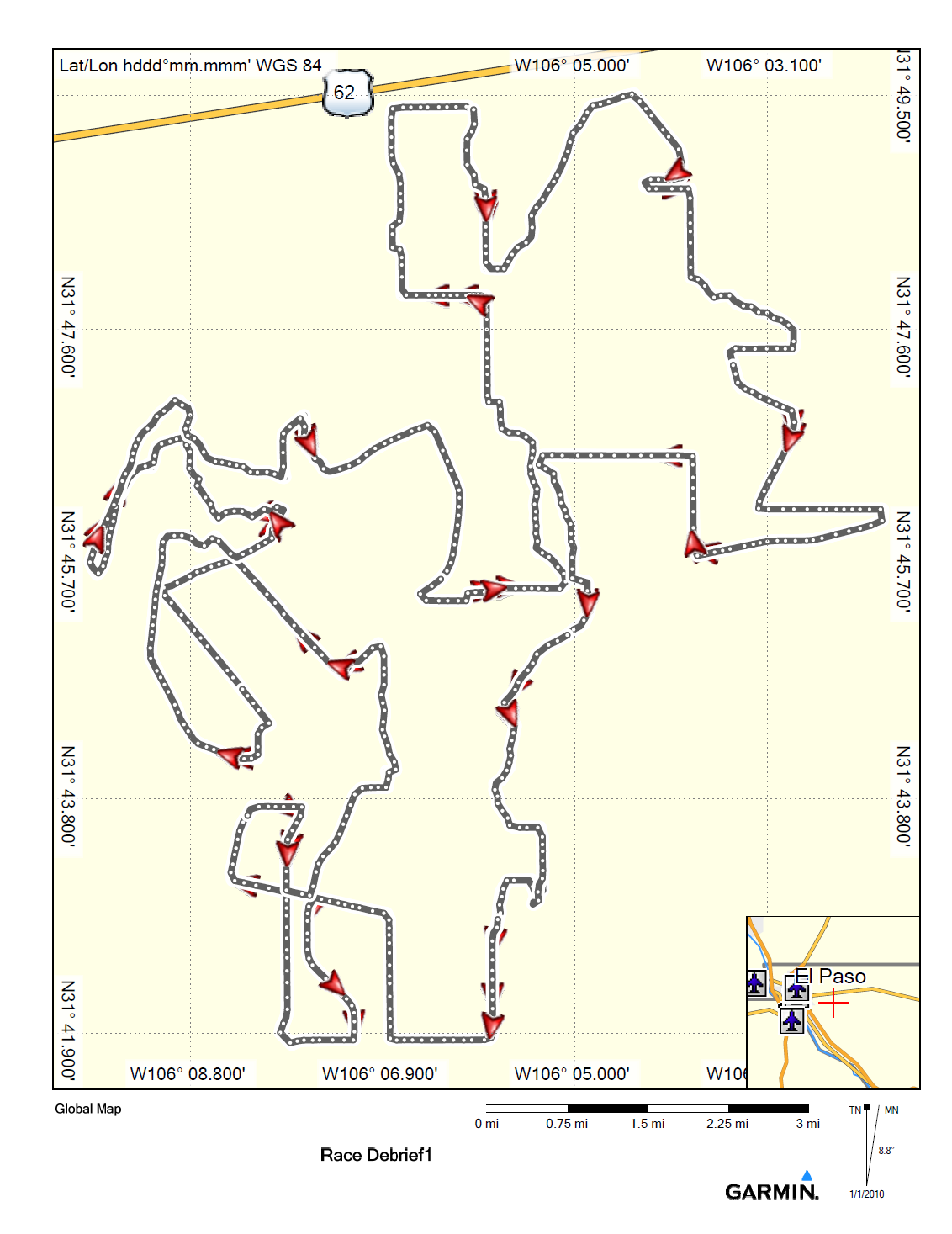
Race Results and Data
This covers the races we have done and the results thereof. GPS data is also included for those who are curious like us.
Baja 1000,2023_________DNF
Cinco De Baja 300,2023____2nd
Scroll down for details!
Baja 1000, 2023
PHOTO CREDIT: BAJA OFFROAD
Sportsman’s class. We did not finish! We stopped at RM 366.6 with mechanical failures. Many of the DNF’d race vehicles stopped before RM 340, so we’re grateful to get past the brutal silt beds and pass many stuck, broken cars. The vast majority of race teams did not finish this 1000, it was a brutal 1300 mile course with a 50 hour time limit.
Distance Completed
560.0 Kilometers
366.6 Miles (30.6% complete)
Average Speeds
29.0 KPH (46.7 KPH moving)
18.0 MPH (29 MPH moving)
When and Where
La Paz, BCS Nov 16-18 2023
Sportman’s Class
DNF (Did not Finish)
Fuel Used, 91 Octane
106.74 Liters / 18.1 L/100Km
28.2 gallons / 13 mpg
PHOTO CREDIT: COIN TV
The Race was 1210 miles long for the Sportsman’s course. We earned 366 of them.
This year’s Baja 1000 was a point to point race. However, it was unique. The race started in La Paz and ended in Ensenada. That’s opposite of every other point to point race in the 50+ year history of SCORE! The pro’s had to drive 1310+ Race miles—it was the longest Baja 1000 in history. The only race that is longer was the Baja 2000 way back when. This year’s 1000 was brutal!
The logistics of this race are hard, and very human. Most teams keep more people in northern part of the peninsula and merely maintain a skeleton crew close to La Paz. That was flipped. Now the main chase teams had to start in La Paz and have all of the team support at the bottom of Mexico. There was carnage at the starting line, and teams rushed to fix their cars before the green flag waved.
Our team consisted of four sets of drivers with co-drivers, four chase crews and three pre-runners. Two of the chase crews made it to La Paz, and the other two stayed up North in San Felipe. The north teams preran all of their sections while the first two teams weren’t able to prerun much with mechanical issues.
Unfortunately, the race abruptly stopped when the 2nd team suffered mechanical failures. We called the race when we couldn’t find parts to fix the 4runner. The race was brutal, and our 4runner faired much better than many cars that slogged through the silts at RM 330. We earned all the damage to the truck. More importantly, we earned every singe race mile we drove. We raced in the Baja 1000!
PHOTO CREDIT: DESERTBAJA.MX
PHOTO CREDIT: DESERTBAJA.MX
PHOTO CREDIT: BAJA OFFROAD
Detailed Race Recap
Ever wondered what it's like to race in the Baja 1000? On November 16th, 2023, Good Mayhem Racing attacked the Baja 1000, and the 4Runner earned some battle scars.
At the start line, Thomas and I noticed we had a driver front shock leak. That freaked me out, and I had to clear my head before we moved. We were the first sportsman’s truck to start, just behind the Class 11, or classic VW bugs. The course starts on La Paz’s waterfront, and crowds lined the streets as the blue ocean sparkled to our right. Imagine the start of a fast and furious movie or a video game; it was packed with people. The green flag waved–We launched, and the 4Runner accelerated silently. Compared to the other loud cars, the 4Runner was quiet. So quiet, we had to use the car horn and sirens to get spectators out of the way throughout the race.
This course was brutal, but the first 300 miles went flawlessly. The silt beds were oceans of talcum powder, and the truck swam through them in 4x4, 1st gear, no problem. Within the first thirty miles, we were caught behind several multi-car pileups. Class 11 bugs were stuck in big 4-foot whoops and loose sand. Someone needed medical assistance. We traversed the rock ledges with no issues. At one point, a race truck was stuck in a mud hole and blocked the course—we found a way around it. We did our best to keep the transmission cool, but we overheated it once getting around that mud hole. While negotiating a siltbed 70 miles in, another race car impacted our left side. It was an accident; no one can see in a cloud of a silt. Imagine the worst fog of your life, but brown.
At race mile 105, we had our first pit. Colin and Thomas refueled. Colin worked on the front suspension by grinding the bolt head that caused the shock’s leak, and he recharged the shock with nitrogen. Kelli took video and helped all around. From there, we took it easy to save the car for the finish line. From Race Mile 170-250, we drove through continuous 3-4 foot tall whoops and several water crossings. A side-by-side ran head-on into a 40-foot-tall cactus (the cactus won). From Race Mile 250-300, we drove through two extremes: harrowingly narrow farm roads lined with cacti, and riverbeds. We saved the car for the next team, but we lost the back hatch and the snorkel’s head too. The radio antenna flapped around after brawling with tree branches. Thomas and I averaged 43 MPH moving speed, with an average of 13 miles per gallon fuel consumption. In comparison, most other race cars get 3-6 miles per gallon in a race like this.
At Race Mile 299, we stopped and changed drivers. Ron setup Pit 2 and flagged us down. We had more than half a tank of gas upon arrival. We expected to be completely empty, so we had 2x more fuel than we needed. Thomas, Colin and I refueled. We used big, 11-gallon dump cans, which were awkward to handle. Colin was drenched in fuel when gasoline came out of the jug’s vent tube. Fortunately, he was wearing his fire resistant clothing and fuel apron, so he was fine. Ron helped with supplies, water and lights. Duc and Sam C. got in the 4Runner. I gave Duc recommendations on how to drive in the silt beds. Thomas helped Sam C. get belted into the car and wired to comms, and we changed out the Camelbacks for the new drivers. Colin recharged the leaky shock with nitrogen again and checked the car all around. I changed the air filter as the local restaurant staff cheered us on. The restaurant owners asked to keep the used filter for their memorabilia wall, and we were happy to let them have it. The race truck left after only 10 minutes: a reasonably quick pit stop, especially for a brand new team.
Duc and Sam C. headed into the deep silt beds near Race Mile 330 and fought hard. They had to back up several times to navigate around stuck cars. Both front tires blew, sequentially losing each bead as they rolled over a berm–other cars littered the course, buried four feet deep. Ron, Thomas and I met up and gave them fresh tires. Duc and Sam C. continued through more silt beds and winched themselves out a few miles later. The winch proved to be an invaluable tool for the night driving portion: Duc and Sam C. winched through multiple obstacles, using cacti and trees as a winch point. At Race Mile 345, the course changed, and the next section was an abandoned, decaying highway intermixed with tall concrete slabs and washed-out terrain. The concrete ledges were a foot tall, abrupt and jarring. These obstacles would pound any suspension, even at slow speeds.
At Race Mile 366.6 on the #Garmin, the left front spindle failed and the lower ball joint ripped out its bolts. There was no obvious obstacle or rut that caused it. The race course was a gravel road at that point. The steering knuckle’s threads were sheared clean. Duc and Sam C. tried to Macgyver the spindle back together, but it gave way again. They spent the rest of the night on the mountain, suited up with helmets in the 4Runner.
Before the race started, the race organizers warned that going on the course and trying to help late at night was one of the most common ways chase team members get killed. We were facing that risk, four hours before dawn. We could not get to Duc and Sam C. on the mountain, because it was twilight on the live race course. We were all stuck in a waiting game until sunrise.
Meanwhile, the North team dutifully pre-ran their 600 miles of course over and over. Steve, Cory, Daron, and Sam G. prepped for their driver changes and coordinated with Score on the team’s behalf. They then camped out in their rigs for the race night, sleeping far from home base. Steve, Daron and Sam G. patiently worked with me over satellite phones to plan our next moves safely.
With stress levels high, two south chase teams had to wait until dawn to help Duc and Sam C. again. We didn’t have a second spindle, and none could be found. I even begged a local to let us use parts from his 4Runner. Turns out the owner of the car was in another race car himself. They couldn’t reach him to get his permission, so they couldn’t help. Multiple locals with satellite phones called around trying to find parts. Colin and Kelli searched for parts in Loreto, but with no success. We were out of luck.
Empty handed, Ron and I drove his SXS on the unpaved highway to assess the damage on the 4Runner. Kelli and Colin met Thomas at the race access-point near VCP89. Ron and I verified it was not possible to get a trailer to the 4Runner, 30 miles deep in the mountains. When we met Duc and Sam C., we lashed the suspension back together with the winch and drove on it for 20 miles. The winch line failed a few miles away from the staged chase team.
That’s when we called the race.
I stayed with Duc and Sam G. while Ron drove back for reinforcements. We opened the survival supplies onboard the 4Runner. The three of us rested, drank water, and ate food. Colin got Chase Truck 1 up the trail, and we dragged the 4Runner out on Maxtrax. Unfortunately, rocks ate through the thin plastic, and the Maxtrax only survived for about three miles. I steered the 4Runner and tried to stop the control arm from hanging up on rocks. Colin diligently tried strap method after strap method to tow the 4Runner while saving the truck that dragged it. We got it back on the trailer with the winch. By the time we made it back to the rest of the Chase Team, we were spent, and it was time to head to San Felipe and commiserate with the North Team. At VCP 89, we were 2000 miles away from home–in the middle of nowhere.
In a span of two weeks, our team collectively drove over 20,000 miles to race a 25-year-old 4Runner in the Baja 1000. Steve, my Baja mentor in all of this, guessed that we had about a 30% chance of finishing the Baja 1000. As fate would have it, we made it through 30.6% of the race course before ringing the bell of defeat. We certainly found the weak spot in the suspension the hard way.
But hey, that’s Baja! Welcome to Desert Racing, baby!
Spunk the 4Runner will return. To be continued…
Welcome to Baja.
Lesson’s learned
As a team, we overdrove the truck.
The frame needed reinforcement around suspension connections. It’s bent on the front subframe and the left rear.
The spindles need to be upgraded. There are none currently avaliable in industry today.
The front suspension had a binding issue with the front shock fittings—those fittings failed and blew the shocks.
Prerunning is essential. If you’re going to race, bring a prerunner. Your life and wellbeing will depend on it. As a team, we preran 640 miles out of 1210 miles, and the vast majority of that was done by the teams up north.
To race a truck, you need a 2nd, if not a 3rd truck for parts.
Every chase team needs standardized sat comms. We were one garmin short of a full compliment, and that proved difficult. Only one chase team had starlink. Everyone did have race-spec race radios though—that was helpful for short ranges, but long needed sat comms.
The Garmin race edition is better than sat phones. Sat phone’s will be secondary next time.
The rear axle needs to be replaced with one wider to match the front wheel’s track width.
The rear shocks need to be outboard of the frame.
The rear needs a 4 link or 3 link to prevent the kind of damage earned.
Cinco De Baja 300
Sportsman’s class. We got 2nd place! Sportsman’s class only required 3 laps, and the pro’s tried to complete five. Most race vehicles stopped after 2 laps, and from the data that’s out there, only two teams finished at all.
Distance
312 Kilometers
194 Miles (3 laps)
Average Speeds
36 KPH (40.7 moving)
22.4 MPH (25.3 moving)
When and Where
El Paso, TX May-6 2023
Sportman’s Class
2nd place
Fuel Used, 87 Octane
91.80 Liters / 29.4 L/100Km
24.5 gallons / 8 mpg

Each lap was 67 miles long (108 Km)
The lap was made up of two significant loops, one mostly desert and silt driving, the other gravel, silt and rock throughout. We pounded our left front tire in the rock section and had to swap out a spare. That tire change at mile ~42 took half an hour too long, and that really dented our time. We were only lapped once by the pro’s, but we weren’t lapped by them again later. They should have lapped us twice to even have a remote chance of finishing five laps. That gives you an idea how many race teams didn’t finish the day.
Lesson’s learned
4x4 is very civilized in the desert. Where V8 2wd racecars were wide open trying not to get stuck, we could meander over the silt at our average speed.
The 4runner is on it’s OEM muffler. It’s quiet. It’s so quiet, we could hear the surrounding wildlife at speed. Every other car on the race course was much louder. We’re keeping that.
V8’s are overrated for a truck this size. The 4runner a Class 3 short wheelbase 4x4. It’s stock V6 has more power than the 105” wheelbase can use, and our 8 mpg fuel consumption rocked.
The 4runner is undersprung. Sure, the springs hold up the truck while it’s moving, but they’re too soft at speed. Call it slow suspension frequency, but the truck’s suspension is soft for trail driving, too soft for racing. The roll cage really stiffened the frame to the point where the suspension finally flexes as it’s intended. It needs more spring.
The 4runner needs secondary bumpstops. Hydro bumps, airbumps, something to make the transition to full compression smoother and less painful for the truck.






















